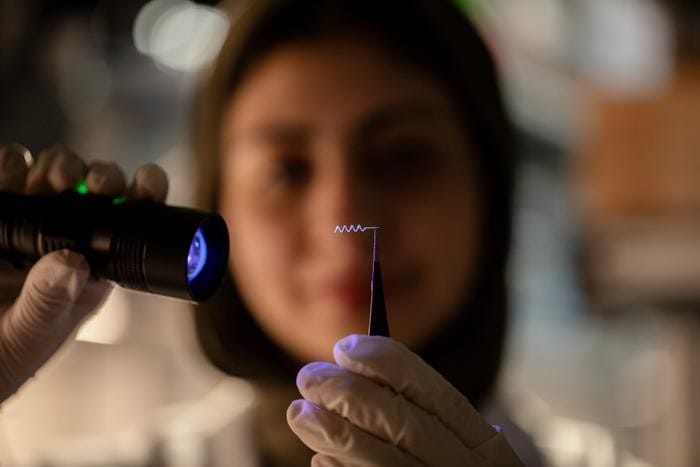Science
New Spiral Catheter Revolutionizes Brain Drug Delivery Methods

Researchers at New York University Abu Dhabi have developed an innovative catheter that enhances drug delivery to entire regions of the brain. Led by Batoul Khlaifat, this new technology has the potential to improve treatments for various neurological disorders, including Parkinson’s disease, epilepsy, and brain tumors.
Current practices often involve the use of microfluidic catheters, which deliver controlled doses of medication to highly localized areas. Although these devices, made from flexible materials, are less invasive than previous models, challenges remain. As Khlaifat points out, “Catheter design and function have long been limited by the neuroinflammatory response after implantation, as well as the unequal drug distribution across the catheter’s outlets.”
The complexity of the brain’s structure poses significant challenges. Each region has irregular shapes that complicate targeted drug delivery. Traditional methods require multiple insertions from a single port or the use of multiple catheters, both of which can be invasive and increase the risk of additional trauma to the brain.
To address these issues, Khlaifat and her team evaluated existing catheter designs, which typically consist of simple tubes with single input and output ports. By utilizing fluid dynamics simulations, they examined how altering the position and number of output ports along the catheter could improve drug distribution. They adjusted the diameters of these ports to ensure that the total flow was evenly distributed among them.
Building on this foundation, the researchers designed a helical catheter named SPIRAL (Strategic Precision Infusion for Regional Administration of Liquid). This new design optimizes drug delivery while maintaining minimal invasiveness. Team member Khalil Ramadi explains, “The helical shape allows us to resist buckling on insertion, which is a major problem for miniaturized straight catheters.”
In controlled laboratory experiments, the team verified their simulations, confirming that the catheter achieved even outflow rates across its outlets. Further tests involving mouse models indicated no significant differences in neuroinflammatory response between the helical catheter and its straight counterpart, establishing safety for future applications.
With promising results, the researchers are enthusiastic about the potential of SPIRAL to change the landscape of targeted drug delivery within the brain. The ability to provide more precise treatment with smaller and controlled doses could make this next generation of implanted catheters both safer and more effective than those currently in use.
The tailored design of these catheters may allow for optimization based on individual patient needs. “These catheters could be optimized for each patient through our computational framework to ensure only regions that require dosing are exposed to therapy, all through a single insertion point in the skull,” says Mahmoud Elbeh, another team member. This personalized approach could significantly improve therapies for brain disorders, including epilepsy and glioblastomas.
The findings of this study are detailed in the Journal of Neural Engineering, showcasing the potential for a significant shift in how neurological conditions are treated through advanced catheter technology.
-

 Entertainment3 months ago
Entertainment3 months agoAnn Ming Reflects on ITV’s ‘I Fought the Law’ Drama
-

 Entertainment4 months ago
Entertainment4 months agoKate Garraway Sells £2 Million Home Amid Financial Struggles
-

 Health3 months ago
Health3 months agoKatie Price Faces New Health Concerns After Cancer Symptoms Resurface
-

 Entertainment2 weeks ago
Entertainment2 weeks agoCoronation Street Fans React as Todd Faces Heartbreaking Choice
-

 Entertainment3 months ago
Entertainment3 months agoCoronation Street’s Carl Webster Faces Trouble with New Affairs
-

 World3 weeks ago
World3 weeks agoBailey Announces Heartbreaking Split from Rebecca After Reunion
-

 Entertainment3 months ago
Entertainment3 months agoWhere is Tinder Swindler Simon Leviev? Latest Updates Revealed
-

 Entertainment4 months ago
Entertainment4 months agoMarkiplier Addresses AI Controversy During Livestream Response
-

 Science2 months ago
Science2 months agoBrian Cox Addresses Claims of Alien Probe in 3I/ATLAS Discovery
-

 Health5 months ago
Health5 months agoCarol Vorderman Reflects on Health Scare and Family Support
-

 Entertainment4 months ago
Entertainment4 months agoKim Cattrall Posts Cryptic Message After HBO’s Sequel Cancellation
-

 Entertainment3 months ago
Entertainment3 months agoOlivia Attwood Opens Up About Fallout with Former Best Friend













